The UO Sexual Violence and Institutional Betrayal Surveys: 2014, 2015, and 2015-2016
Assessing Sexual Assault, Sexual Harassment, Perpetration, Institutional Betrayal, Student Attitudes, Student Health, Educational Engagement, and Participant Experience with the Survey
Professor Emerit of Psychology, University of Oregon
Faculty Affiliate of the Women's Leadership Innovation Lab at Stanford University
A Note about the Credibility of Research that Reveals Information that May Impact the Reputation of the Instituiton.
It is important to use the tools of science to ensure both solid research methods and credible findings. See:
Freyd, J.J. (2014) Use science as tool on campus sexual assault. [Op-Ed] The Register-Guard (Eugene, Oregon), November 9, 2014, p H4.
Full text Here.
The Survey Project 2014
In late summer 2014 two of my doctoral students, Marina N. Rosenthal and Carly Parnitzke Smith, and I administered an on-line survey to a sample of undergraduate University of Oregon (UO) students. This survey, approved by the UO's Institutional Review Board, was designed to assess student experiences of sexual victimization, perpetration, and institutional behaviors, as well as student attitudes and well-being. Data collection occurred during August and September of 2014, prior to the start of Fall term classes. This project is similar to other studies we have completed in our laboratory and it overlaps with the survey recently recommended by the White House.
Measurement Instruments |
Survey Packet used Late Summer 2014 (Registrar sample - undergrads only) |
| Publications from the 2014 Survey data |
Gomez, J. M., Rosenthal, M. N., Smith, C. P., & Freyd, J. J. (2015). Participant reactions to questions about gender-based sexual violence: Implications for campus climate surveys. eJournal of Public Affairs: Special Issue on Higher Education’s Role on Preventing and Responding to Gender-Based Violence, 4(2), 39-71.
Smidt, A.M., Rosenthal, M.N., Smith, C.P., & Freyd, J.J. (2021). Out and in Harm's Way: Sexual Minority Students’ Psychological and Physical Health After Institutional Betrayal and Sexual Assault. Journal of Child Sexual Abuse, 30, 41-55, DOI: 10.1080/10538712.2019.1581867.
Barnes, M.L., Adams-Clark, A.A., Rosenthal, M.N., Smith, C.P, & Freyd, J.J. (2021). Pledged into harm: Sorority and fraternity members face increased risk of sexual assault and sexual harassment. Dignity: A Journal on Sexual Exploitation and Violence, 6 (1), Article 9, DOI: 10.23860/dignity.2021.06.01.09 |
| Initial Results Presented at Conferences |
- Smith, C. P., Rosenthal, M. N., & Freyd, J. J. (October, 2014). Assessing campus climates: The role of institutional betrayal in campus sexual assault research. Presented by Mary Koss at the GSU College Sexual Assault Forum: From Campus Climate to a Coordinated Response, Atlanta, GA, 22-24 October 2014.
- Freyd, J.J. (October, 2014). Institutional Betrayal. Plenary presentation at The 31st annual meeting of the International Society for the Study of Trauma and Dissociation, Long Beach, California, 25-27 October 2014.
- Freyd, J.J., Smith, C. P., & Rosenthal, M. N., (November 2014). Research on Institutional Betrayal: The Case of Campus Sexual Violence. In Symposium: “New Directions in Campus Sexual Assault Research,” at The 30th Annual Meeting of the International Society for Traumatic Stress Studies (ISTSS), Miami, Florida, 6-8 November 2014.
- Smidt, A.M., Smith, C.P., Rosenthal, M. & Freyd, J.J. (August, 2015). Out and in Harm's Way: Sexual Minorities' Health Following Institutional Betrayal and Sexual Assault. Presentation for the 123rd Annual Convention of the American Psychological Association, Toronto, Ontario, Canada, 6-9 August 2015.
- Gomez, J. M., Rosenthal, M. N., Smith, C. S., & Freyd, J. J. (August, 2015). Reactions to sexual violence questionnaires: Implications for campus climate surveys. Poster presented at the 20th International Summit & Training on Violence, Abuse, & Trauma, San Diego, CA, San Diego, CA, 23-26 August 2015.
|
| |
Scroll down for more findings from our 2014 survey |
The Survey Project 2015 (and with Replication using HSP 2015-16)
We administered a second survey in late spring 2015. The UO President's office provided funding for students participating in this survey and for students hired to help adiminister the survey. This second survey included -- but was not limited to -- a full pilot of the ARC3 Survey. In addition we administered this same survey to a different sample on our campus during the 2015-16 academic year.
Measurement Instruments
|
|
| Publications from the 2015 Survey and/or the 2015-16 Replication |
Rosenthal, M.N., Smidt, A.M., & Freyd, J.J. (2016). Still second class: Sexual harassment of women graduate students. Psychology of Women Quarterly. (DOI: 10.1177/0361684316644838)
Sexual harassment compromises graduate students' safety by Marina Rosenthal, Alec Smidt, and Jennifer Freyd, The Conversation, 18 May 2016.
Rosenthal, M. & Freyd, J.J. (2018). Sexual Violence on Campus: No Evidence that Studies Are Biased Due to Self-Selection, Dignity: A Journal on Sexual Exploitation and Violence: 3,. 1, Article 7. DOI: 10.23860/dignity.2018.03.01.07
Gómez, J. M. (2021). Gender, campus sexual violence, cultural betrayal, institutional betrayal, and institutional support in U.S. ethnic minority college students: A descriptive study. Violence Against Women, Advance On-Line. (DOI: https://doi.org/10.1177/1077801221998757)
|
| Initial Results Presented |
- At the 20th International Summit & Training on Violence, Abuse, & Trauma, San Diego, CA, San Diego, CA, 23-26 August 2015. The slides from IVAT are posted here.
- At the the University of Oregon Senate, Eugene, Oregon, 7 October 2015. The slides from Senate are posted here.
|
More about the 2015-2016 Replication Study (Is Self Selection Explaining our Findings?)
- One important goal of the 2015 study was to get a sample representative of current University of Oregon undergraduates. We thus started with a random sample of emails that were representative of current students. We offered compensation to potential participants in order to increase the response rate and in order to motivate students based on something other than intrinsic interest in the subject matter. Self-selection is nonetheless a factor to consider as a potential threat to representativeness. We evaluated this in a 2015-16 Replication Study.
- Rosenthal, M. & Freyd, J.J. (2018) Sexual Violence on Campus: No Evidence that Studies Are Biased Due to Self-Selection, Dignity: A Journal on Sexual Exploitation and Violence: 3,. 1, Article 7. DOI: 10.23860/dignity.2018.03.01.07
- Open Access Full Text: http://digitalcommons.uri.edu/dignity/vol3/iss1/7/
- Abstract: Numerous research studies suggest that at least one in five female college students is sexually assaulted while enrolled. However, many studies exploring sexual violence prevalence on campus use methodology permitting students to self-select into the study based on interest in the topic (i.e., students receive an email offering them the opportunity to participate in a study on sexual violence). Self-selection may bias these prevalence estimates of campus sexual violence. To explore this issue, we surveyed two samples of college women on their experiences of sexual assault. We recruited Sample 1 in a typical way: by emailing a randomly selected subset of students provided by the university registrar and inviting participation with information about the survey topic. We recruited Sample 2 using a human subjects pool where students in introductory psychology and linguistics courses sign up for studies without prior knowledge about the topic of the research they will participate in (hence greatly minimizing the risk of self-selection). The two samples yielded nearly identical victimization rates. Over a quarter of participants in both our samples had experienced sexual contact without consent, consistent with recent research from the Association of American Universities. College victimization estimates do not appear to be biased by self-selection based on knowledge of the survey topic.
Creative Commons License
- This important feature -- guarding against self-selection -- of the UO HSP is discussed in some detail here.
- Also see: Freyd, J.J. (2015). Examining Denial Tactics: Were Victims Overrepresented in the AAU Survey of Sexual Violence on College Campuses? The Blog, Huffington Post, September 29, 2015.
Measurement Packets
Research Aims, 2014
We constructed and administered our survey with the goals of contributing to research on the psychology of sexual violence and the behavior of an institution in response; contributing to the current national efforts to create a standardized survey; and contributing to the University of Oregon by providing data to help guide policy and implementation decisions. We also hope the data will help inform the UO Senate Task Force to Address Sexual Violence as it arrives at its recommendations for this campus.
Funding and Budget, 2014
Funds for participant compensation were provided by Center for the Study of Women in Society and private donations made through the UO Foundation. The total monetary budget was $20,000, which was entirely for modest participant compensation ($20 per participant for up to 1,000 participants), a standard survey procedure. University and UO Foundation resources normally available to the investigators, such as licensed software and accounting support, were used. The investigators provided labor (including survey construction, administration, and analysis).
Survey Method, 2014
This survey is based on a compilation of social science survey instruments with a focus on sexual victimization, perpetration, institutional behaviors, and student well-being. We primarily used and modified existing instruments; additionally, we created some new items specifically for this study. This on-line study was administered by the use of Qualtrics software licensed to the University of Oregon. Our goal was to survey 1000 students. We anticipated a 20% response rate. Five thousand student emails were provided by the UO Registrar on August 19, 2014. These email addresses were selected randomly by the Registrar from the population of degree-seeking undergraduate students who were (as of August 19) currently registered for Fall 2014, who were registered as degree-seeking undergraduates some time during Fall 2013, Winter 2014, or Spring 2014, and who were (as of August 19) at least 18 years old. Between August 27 and September 19 we rolled out email invitations in batches; students had 10 days to complete the web-based survey. (This was late summer for our students; the first day of Fall term classes was September 29.) There was one reminder to students on day 5. Each participant was offered compensation in the form of a $20 Amazon.com gift certificate for completing the survey. We closed the survey data collection on 29 September with 982 completed surveys and 76 partially completed surveys. Survey completion time was estimated to take about 30 minutes per participant. We used Qualitrics "Display Logic" such that questions presented to participants often depended upon their answers to prior questions. A list of measures and an electronic print-out of our on-line survey instrument can be found here.
The Preliminary Results, 2014
At a meeting of the UO Senate Task Force on Tuesday September 30 we first reported some key findings from the survey that seemed relevant to informing the Task Force in formulating recommendations. At the time we explained that it would: " take months to do a thorough analysis of the data. As this occurs, we anticipate we will be sharing the data in a number of ways in addition to the presentations we make locally: we plan to submit papers for peer review in archival journals; we expect to present results at scholarly/scientific conferences; and we hope to make the survey instrument and, pending IRB approval, raw data available in open access format as soon as that is feasible. Our goal is to give this research away in the most complete and transparent fashion possible so that it can best help our local and national efforts to understand and end campus sexual violence.
Research Findings, 2014
| Some of the Questions Addressed |
Results Document |
Sample Graphs
|
- What did students think about participating in this study?
- At what rate are students experiencing sexual harassment?
- At what rate are students being sexually victimized?
- What do we know about victim-perpetrator relationship and perpetrator gender?
- Where are nonconsensual events occurring?
- Does minority status impact risk?
- Do students report assaults to university sources?
- How do victimized students experience institutional climate and response?
|
September 30, 2014 Presentation to the UO Senate Task Force: Preliminary Findings |
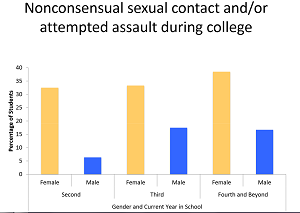 |
- At what rate are students experiencing rape
|
October 2, 2014 Update Regarding Percentage of Students Subjected to Rape |
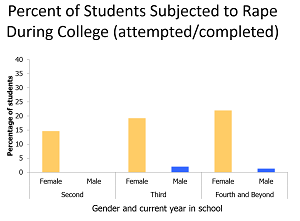 |
- Are students aware when their behaviors and experiences meet the definitions of sexual assault or rape?
- What have participants observed happening to their friends who were sexually assaulted?
|
October 3, 2014 Update Regarding Friend Experiences, Institutional Behavior, Experience Labeling |
|
- How many nonconsentual sexual incidents did students indicate?
|
October 13, 2014 Number of Incidents Indicated and Reported,
Provided to the University of Oregon AAEO |
 |
- Does affiliation with the Greek system relate to rates of sexual violence?
|
October 14, 2014 Greek Life and Rates of Sexual Violence
Also see: Barnes, M.L., Adams-Clark, A.A., Rosenthal, M.N., Smith, C.P, & Freyd, J.J. (2021). Pledged into harm: Sorority and fraternity members face increased risk of sexual assault and sexual harassment. Dignity: A Journal on Sexual Exploitation and Violence, 6 (1), Article 9, DOI: 10.23860/dignity.2021.06.01.09 |
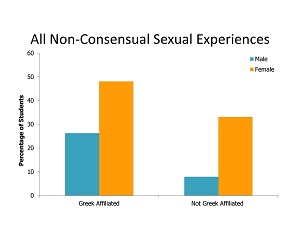 |
- At what rate are students experiencing gender harassment? (slides 14-16)
- Is status of perpetrator as UO student associated with institutional betrayal experienced by victim? (slides 30-33)
- Is institutional betrayal associated with educational disengagement (e.g. decreases in participation in activities, honor societies, living on campus, etc) following a nonconsensual experience? (slides 34-36)
|
October 23, 2014 Presentation for GSU College Sexual Assault Forum, 22-24 October 2014*
*This file includes some repeats from earlier presentations. The new material is on slides 14-16 and slides 30-36. The full citation for this presentation is: Smith, C. P., Rosenthal, M. N., & Freyd, J. J. (October, 2014). Assessing campus climates: The role of institutional betrayal in campus sexual assault research. Presented by Mary Koss at the GSU College Sexual Assault Forum: From Campus Climate to a Coordinated Response, Atlanta, GA, 22-24 October 2014. |
 |
- What role do substances play in sexual assaults that occur in the context of fraternity and sorority life compared to other contexts?
- Are UO student perpetrators more likely to use substance facilitation compared to non- UO students?
|
November 4, 2014 Update Regarding Substance-Assisted Coercion and Fraternity Location of Assaults |
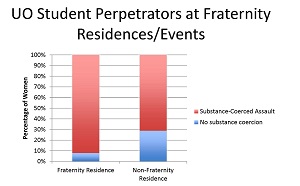 |
- Are students participating in varsity, club, and intramural athletics at higher risk for victimization?
- Do undergraduate participants indicate problem drinking and substance use?
|
November 21, 2014 special report for the Intercollegiate Athletics Committee*
*new results on slides 11-16 |
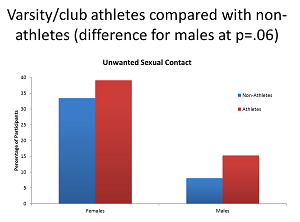 |
Audio Files of Presentations or Discussions of the Research by the Investigators
Also see:
- The Science of Campus Victimization Surveys
- Smith, C.P. & Freyd, J.J. (2013). Dangerous Safe Havens: Institutional Betrayal Exacerbates Sexual Trauma. Journal of Traumatic Stress, 26, 119-124.
- Smith, C.P. & Freyd, J.J. (2014). Institutional betrayal. American Psychologist, 69, 575-587.
- Freyd, J.J. & Birrell, P.J. (2013). Blind to Betrayal. John Wiley & Sons, Inc.
- Institutional Betrayal Research Page
- Journal of Trauma & Dissociation
- Freyd Dynamics Lab






